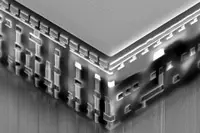 Resistive RAM pioneer Crossbar says it has developed a method which suppresses the sneak path current; an effect which makes it difficult to read data reliably from individual memory cells. Without this ability, the company says, RRAM developers cannot deliver high density 3D memory arrays.
Resistive RAM pioneer Crossbar says it has developed a method which suppresses the sneak path current; an effect which makes it difficult to read data reliably from individual memory cells. Without this ability, the company says, RRAM developers cannot deliver high density 3D memory arrays.
The company came out of 'stealth mode' earlier in 2014, when it disclosed its technology, in which one transistor is capable of driving more than 2000 interconnected memory cells. However, reading one particular cell is a challenge because of what's called the sneak path current. While current flows through the cell you're trying to read, it also flows through nearby cells, making it difficult to interpret the data. It also increases power consumption.
Crossbar says it has solved the problem using a super linear threshold layer. Here, a volatile conduction path formed at the threshold voltage creates a 'no leakage' region for unselected memory cells.
Sylvain Dubois, the company's VP of marketing and business development, said: "The challenge with RRAM has been how to read data and the way you look at a cell is critical.
"RRAM data is written by applying a voltage, but read by measuring current. Our solution creates a 'quiet zone' that allows the data in each cell to be read with confidence."
The difference in the on and off currents is said to be as great as 1010, whilst a turn on slope of less than 5mV/dec sees data recovered in less than 50ns.
According to Dubois, these features are additive when it comes to comparing the benefits of RRAM with flash. "RRAM's time to first data is about 1µs, where flash is about 100µs, so it's x100 better. But RRAM has a lower leakage current as feature size decreases, so the difference between the two approaches increases."
Now, Crossbar is transferring its technology to foundries. "The technology is CMOS compatible, so any CMOS foundry can produce memory," Dubois noted.
The company sees two main markets for RRAM technology. One is as embedded memory, where layers of RRAM cells can be manufactured on top of logic. The other is in high capacity storage, where it envisages devices capable of holding terabytes of data.
Author
Graham Pitcher
Source: www.newelectronics.co.uk
